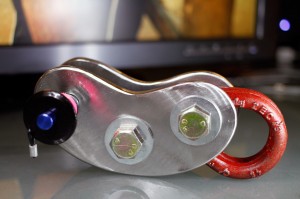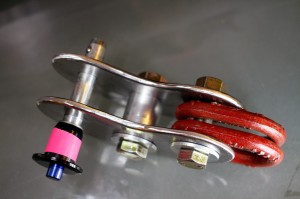Kofi webbing anchor testing
A while ago I published a long-in-the-making article on my custom built Kofi webbing anchors. The article is really dense, but covers most of the aspects of designing a webbing anchor — I published it so that most readers can appreciate the work that the folks at Landcruising and Balance Community put into designing their devices, but also so that for the few who do have engineering degrees and access to machine shops they don’t waste time reinventing the wheel. Rather than add even more density to that article, it’s time to create a second one. This article is a work in progress and will soon include some video tests (see below). So what have I been up to in the last few months? Thanks to a reader with access to a plasma cutter, I was able to cut a batch of 4130 steel plates. The upside of 4130 is that it’s about twice as strong as 6061-T6 aluminum; downside is it’s also three times as heavy. So the steel Kofi is a hair over 1000 grams, compared to the 500 grams of the aluminum version. The side plates are actually thinner than aluminum (.19″ versus .25″), which saves some weight, and I grew the dimensions marginally to add a bit more internal clearance for fatter webbings/hardware as well as a bit of meat to increase break strength (which is now theoretically around 20,000lbs). As you can see in the image linked above, plus in the images below, the steel plates have a hand finished look (since they were roughed out using a plasma cutter), but they
So what have I been up to in the last few months? Thanks to a reader with access to a plasma cutter, I was able to cut a batch of 4130 steel plates. The upside of 4130 is that it’s about twice as strong as 6061-T6 aluminum; downside is it’s also three times as heavy. So the steel Kofi is a hair over 1000 grams, compared to the 500 grams of the aluminum version. The side plates are actually thinner than aluminum (.19″ versus .25″), which saves some weight, and I grew the dimensions marginally to add a bit more internal clearance for fatter webbings/hardware as well as a bit of meat to increase break strength (which is now theoretically around 20,000lbs). As you can see in the image linked above, plus in the images below, the steel plates have a hand finished look (since they were roughed out using a plasma cutter), but they  should work just fine for my needs despite each Kofi having a “one of a kind” hand build. I am working on sourcing bolts that are the exact correct unthreaded-shaft-length, so for now washers are necessary to get the spacing right.
should work just fine for my needs despite each Kofi having a “one of a kind” hand build. I am working on sourcing bolts that are the exact correct unthreaded-shaft-length, so for now washers are necessary to get the spacing right.
What’s on the agenda for the rest of this “work in progress” article? Testing!
Holding power. Lately there has been a lot of debate in the community about the holding power of adjustable webbing anchors. My experience (written about in the first article) has been that any “gap” to the sides of the webbing drastically reduces the holding power, at least for more slippery webbings. (Basically, I would not trust polyester webbings beyond 5000lbs without some other precautions taken.) Others (from Landcruising) have said their tests show this gap makes no difference. Backing up their point of view, Jerry at Balance Community has released the new AWL (“3.0”) with its roller and one sideplate machined as a single piece. That the roller itself cannot “roll” (because it is part of the sideplate) means, Jerry claims, that the webbing, even slippery webbing, will break before it slips. Effectively he is saying that webbing slippage that led to creation of devices like the Monster Lock is from the roller itself turning under load. Although it would make sense that the roller, if it turned, could cause slipping, that it doesn’t jive with my intuition about how well locked in place the roller is or about the torques the roller experiences.
I can do some physics on paper to make my point, but there is so much going on here that actual testing is a much more valid approach. Before that, however, let’s talk just about about friction and why wrapping material around a pole will keep it from slipping. You probably already have a reasonably intuitive understanding of how friction works. For instance, if you have some tension on a rope and you’re going to tie it around a pole, if you wrap the rope several times around the pole and THEN tie it off your knot will be more likely to hold. This is because of the friction involved (and in the next paragraph we’ll dissect that a bit). However, there are also some pretty nonintuitive things that happen regarding friction. For a good explanation of this, since I am not a physicist, listen to a couple minutes from MIT’s always-entertaining Walter Lewin (an actual physicist!). So what makes adjustable webbing anchors so special is the contact angle that takes place when the material is wrapping around the roller and pin. It’s this wrapping that so greatly boosts the holding power.
We know that webbings in the “double wrap” method do not slip, but in the single wrap they do. I have sketched a quick document that explains some of the physics involved when a rope wraps around a pole (which, on a basic level, is sort of what is happening with an adjustable webbing anchor, plus there are some complications on top of that). With some basic (but possibly wildly inaccurate) assumptions about friction of webbing on metal (and neglecting webbing on webbing friction) you can see that a piece of webbing wrapped around a pole (perhaps nonintuitively the diameter of this pole does not affect the calculations) a “single wrap” will hold about 50x the weight of the tail before slipping, versus around 3000x for the contact that takes place in the “double wrap.” But of course the double wrap isn’t adustable, specifically because there is so much friction at play. So the benefit of the single wrap is that if you lift the slackline a bit (so it isn’t pressing down on the front pin) and pull on the tail, you can feed slack into the device. Once you let go of the main line and it is pressing down on the front pin again the physics of the situation have changed such that slippage is now seemingly impossible. So the question is, at a very high tension, when slipping does occur, why is this? It could be the webbing can pop out from under itself, it can be the roller can turn, or it can just be that there is nothing “holding” the tail except its own weight and as my sketching above shows, at some point the tension is enough to overcome inbuilt friction (so for more slippery webbings this is an issue).
Basically what I intend to do in the near future is a series of video tests that will be posted here where I pull the same piece of webbing to a given tension to see if it slips. I plan to test:
- Kofi with huge gap between webbing and side plates (I will use a 1.25″ roller)
- Kofi with no gap but center roller is loose and maybe even “greased” on the sides (where it touches the plates) so it will roll easily
- Kofi with standard center roller and also a front bolt rather than a pin
Break strength. It’s time to test the calculations of the Kofi. With both aluminum and steel versions it would be nice to have a final answer as to how strong they are. I have gone through enough design iterations that it can be hard to remember which version I settled on for the many random prototypes kicking around my apartment, since I keep tweaking the break strength (from 10,000 to 14,000 to 20,000) and I’d like to have a concrete number just to allay my fears that theory doesn’t always translate to practice. As long as the break strength ends up being over 10,000 for all devices then I will happy since there are several other components in a rigging system with lower strength (including the webbing in almost all cases).
Teardrop rings. These suckers are often hard to source in American-made brands and the one readily available source seems to be Chinese. This may not be a problem. Or it may. I’m going to break some, and then we’ll know. They are rated for 1800lbs working load and so far I have only consistently tested them to about 1500lbs (with no issues). I’d like to see them get much closer to the 8000lbs mark before breaking (at which point I would consider them safe).

No comments yet... Be the first to leave a reply!